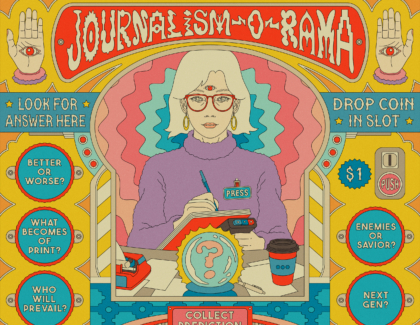Sign up for the daily CJR newsletter.
Last year, Susan Chira announced that she would be stepping down as editor in chief of the Marshall Project, a nonprofit newsroom focused on criminal justice stories, this month. Since launching, in 2014, the Marshall Project has produced investigative work that has gone on to gain widespread recognition, including two Pulitzer Prizes––the first for a story about a failed police investigation into an account of a rape; the second for a story about severe injuries caused by police dogs.
The latter award came while Chira was editor; she joined in 2019 from the New York Times, where she’d worked for four decades. Under her leadership, the newsroom made strides in producing work that communicated the intricacies of America’s criminal justice system and reached those most affected by it. The newsroom doubled in size during this period and explored different modes of reporting, including survey projects and service journalism. It also did work in collaboration with people who have gone through the prison system or been affected by it, including a video series, “Inside Story,” produced by formerly incarcerated people, and News Inside, a print publication for prison libraries.
Recently, before Chira left her post and took some much-deserved time off, I spoke with her about her tenure as editor, the challenge of reaching the audiences most siloed from fact-based information, and telling a fuller story about the criminal justice system. This interview has been edited for length and clarity.
FM: What was the state of criminal justice reporting when you joined the Marshall Project, and what was your vision going in?
SC: When I joined the Marshall Project, it was a little shy of five years old. The founder, Neil Barsky, and the founding editor, Bill Keller, had already created something remarkable that left a significant mark on the criminal justice landscape. However, much of the coverage at the time treated criminal justice as a story of crime rather than a more complex system. There was an enormous gap in reporting about prison conditions and the experiences of incarcerated individuals. Policies from the nineties that led to mass incarceration were not adequately covered or understood. My vision was to look at criminal justice through a broad lens—it touches every aspect of American society, including race, gender, inequality, poverty, and trauma. I wanted to deepen the exploration of these divisive and polarizing issues. I wanted to build up our narrative capacity, too, because it felt to me that these stories are very, very hard to read. They contain very difficult and traumatic events, and it’s really easy for people to just feel like this is too depressing.
What was it like transitioning from a large news organization in the New York Times to an outlet focused on a specific subject?
I loved my nearly forty years at the New York Times. It’s a remarkable organization with immense resources. Moving to the Marshall Project, I often describe it as going from a great battleship—the New York Times has everything it needs—to a smaller nonprofit where we all wear many hats, and resources are more limited. That said, the smaller scale is also very creative and collaborative. Everyone bands together to get things done, and it’s incredibly rewarding. One of the key differences is the need to make hard choices. At the Marshall Project, we can’t do everything, or even most things. We have to focus on what only we can do—stories that are distinct and additive rather than duplicating what others are already covering. For example, when Trump was indicted, instead of doing the same around-the-clock coverage as other outlets, we asked incarcerated people about their experiences of being indicted and compared that with Trump’s treatment. This approach allowed us to bring a unique perspective to a major news event.
You’ve talked about the difficulty of the subject matter and also reaching an audience that shuns the traditional sources of journalism. How does the Marshall Project reach its audience, particularly those most affected by the criminal justice system?
We’ve developed several ways to connect with our audience directly impacted by the criminal justice system. One initiative is News Inside, a print publication distributed in prison libraries. We created “Inside Story,” a video series featuring adaptations of our investigations and animated explainers. Additionally, we’ve published “Life Inside,” a series of essays written by people whose lives intersect with the justice system, including those who are formerly incarcerated. We’re really invested in the idea that some of the work we do is explanatory: What do people want to know? We started a project in Cleveland, which completely stemmed from what the community was interested in. What they talked about was not knowing enough about the court system. We built a database of adjudicated cases and created guides to help people understand it. We held community meetings, distributed fliers in churches and community centers, and used local radio shows to answer questions and share information.
Our partnership model also plays a critical role. We collaborate with local and regional news outlets to ensure our stories reach specific communities. For instance, we share stories with local publications and radio stations in areas relevant to the reporting. Additionally, we launched “Investigate This,” a tool kit offering resources like databases and reporting guides to help local journalists cover criminal justice issues in their communities. Reaching marginalized and underserved audiences requires constant experimentation. We’re learning to connect with people through fragmented platforms like Facebook groups and Reddit threads. It’s about breaking down barriers, understanding what information people need, and ensuring our work resonates with those who often feel alienated or overlooked by traditional journalism.
Thinking back through your tenure, what specific reporting efforts stand out as particularly impactful?
Our reporting on the criminalization of pregnancy. We explored cases where women faced criminal charges after miscarriages or stillbirths, often due to systemic issues like false-positive drug tests. Another was our Pulitzer Prize–winning series on police dogs used as weapons, which involved a multi-partner collaboration. These projects illustrate our ability to dig deep, uncover hidden patterns, and bring nuanced stories to light. I’m particularly proud of our efforts to develop a very extensive network of communication with people who were behind bars, helped very centrally by both a really talented reporter (who’s now an editor) named Nicole Lewis and a guy named Lawrence Bartley, who is formerly incarcerated and is the visionary who helped us dream up an idea to do a print magazine that would be distributed behind bars and then a series of television shows that would translate and animate our work.
In what ways, if any, do you think the Marshall Project has influenced reporting on criminal justice more broadly?
I believe that the Marshall Project can claim some degree of credit––I wouldn’t say it’s all us, but I believe we’ve contributed to trying to raise consciousness about the fact that we need to understand the circumstances and the conditions of people who are really hidden from the public eye. That’s people behind bars, people winding their way through the courts, people who are desperate for their own safety but also don’t want to see their kids randomly pulled over or stopped and frisked. It’s not a gauzy portrait saying everybody is a misunderstood hero or heroine, but it is showing the complexity of their full humanity and how many people in the system inflict trauma who were also deeply traumatized, so you have a fuller understanding of the conditions that lead to these things.
I’ve noticed that stories we might have done alone five years ago are now being covered by major outlets like the New York Times and the Washington Post. For a long time, the Marshall Project was kind of out there alone publishing essays from incarcerated people; now you have the Prison Journalism Project, which is doing all kinds of work on that. I see guest essays in the New York Times from writers who started out writing for the Marshall Project. I see much more coverage of prison conditions. We’ve also helped shift the language and narrative around criminal justice. For example, our Language Project influenced the Associated Press’s style guidelines.
Other notable stories:
- The watchdog group Media Matters for America analyzed TV coverage of the fires in Los Angeles across a two-day period last week and found that only 6 percent of segments across six major broadcast and cable news networks mentioned climate change; the vast majority came on cable, with ABC and NBC not mentioning climate change at all. The website Carbon Brief also assessed coverage of the fires both in the US and internationally, finding that climate explainers “have formed a notable part of the media reaction” in several countries, but that “climate-sceptic media has called into question the role of climate change.” Meanwhile, a new study in the UK found that skepticism about the reality of climate change has all but disappeared from British papers’ opinion pages—though skepticism of climate action has increased; Press Gazette has more.
- Yesterday, Rashida Jones, the president of MSNBC, announced that she is stepping down from the role after nearly four years in charge. “Jones was a historic pick—the first Black person to run a major television news network,” the CNN media reporter Brian Stelter writes. “She recruited new hosts like Jen Psaki and prioritized digital expansions of the MSNBC brand.” Rebecca Kutler, a senior executive under Jones at MSNBC, will succeed her on an interim basis. The news comes as Comcast, MSNBC’s owner, prepares to spin off the network and other media properties into a separate publicly traded entity. Also yesterday, one of the questions raised by that move—whether MSNBC will keep its name—was resolved: a top executive said that it would.
- CBS News created a new position of “executive editor” to oversee journalistic standards and tapped Susan Zirinsky, a former president of the network, to fill it on an interim basis while a permanent appointment is made; in a memo, an executive cited the importance of “balanced, accurate, fair and timely reporting, including highly complex, sensitive issues like the war in the Middle East,” a likely reference to recent charges of anti-Israel bias in the network’s coverage and internal management. Shari Redstone—the chair of CBS’s parent company, who publicly criticized network bosses over an Israel-related staff dispute last year—praised the hiring of Zirinsky in a statement to Jewish Insider.
- Poynter’s Angela Fu explored how a burgeoning “newspaper war” in Baltimore—a rarity in an age of one-paper towns and deep cuts to local news nationwide—has foundered since one of the papers in question, the Baltimore Sun, was taken over by David Smith, the chairman of the TV chain Sinclair; the latter company “is known for forcing stories with a right-leaning agenda” on its stations, Fu writes, and “some of those changes have come to the Sun, where readers are taking notice” and many staffers have recently quit. Meanwhile, the rival Baltimore Banner, a new-ish nonprofit site, is “ascendant.”
- And for CJR, Ayman Oghanna, a conflict reporter, writes about his diagnosis with bipolar disorder and the stigma attached to such conditions within the media industry. “Even now, as I write this, I can’t shake the fear that it might end my career. But I have to say it out loud and to speak up for the many other journalists I know who cannot,” Oghanna writes. “Mental illness runs deep through our profession. There are many journalists hiding from the stigma of mental health, addiction, or both, trying not to appear as damaged goods and to keep on working. I want them to know that they are not alone.”
Has America ever needed a media defender more than now? Help us by joining CJR today.







